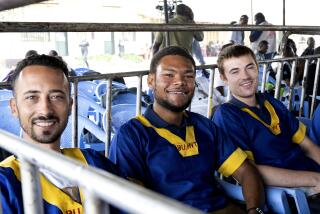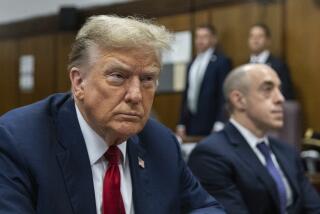Hasenfus Hears Formal Charges in Nicaragua
- Share via
MANAGUA, Nicaragua — American Eugene Hasenfus, captured while trying to deliver arms to U.S.-backed Nicaraguan rebels, went on trial Monday before a revolutionary court on charges of terrorism and violating national security laws.
In a hot and stuffy courtroom, Reynaldo Monterrey, president of the Popular Anti-Somocista Tribunal, read an indictment that also charged Hasenfus with violating public order and conspiring with the anti-Sandinista contras against the government. Monterrey said government documents turned over to the court included Hasenfus’ confession.
‘True Face of Mercenary’
“No camouflage can cover the true face of the mercenary attack on the sovereignty of our people,” Monterrey said.
Hasenfus, who arrived at the courthouse at 5:15 p.m. in an armored car in the custody of Sandinista security police, sat impassively while the charges were read, first in Spanish, then in English. His wife, Sally, and his brother, William, stood behind him as photographers flashed their cameras.
Hasenfus and his wife did not speak during the hearing but afterwards met in offices adjoining the courtroom. They embraced, and Hasenfus burst into tears, said news photographer Arturo Robles, who witnessed the scene.
Called ‘Kangaroo Court’
U.S. Consul Donald Tyson was also present at the session. U.S. Embassy officials here, who have been allowed to meet with Hasenfus for only 11 minutes, have called the revolutionary tribunal a “kangaroo court” and noted that acquittals are rare.
At the end of Monday’s proceedings, the judge asked Hasenfus if he had anything to say. Hasenfus replied that he would have nothing to say until he had seen a lawyer. If convicted, Hasenfus, 45, would face up to 30 years in prison, Sandinista officials have said. However, in the indictment no sentence is listed beyond three years.
To Seek Maximum Penalties
In any case, the government will seek the maximum penalties for Hasenfus. “He is an extremely dangerous element,” the indictment said.
Hasenfus was captured Oct. 6 by government troops in southern Nicaragua, after parachuting the day before from a C-123 cargo plane shot down with a Soviet-made missile. The plane was carrying AK-47 rifles and ammunition along with hand grenades for delivery to the contras.
Two other Americans on board, pilot William J. Cooper of Reno and co-pilot Wallace B. Sawyer Jr. of Magnolia, Ark., were killed when the plane crashed, as was a fourth crew member reported to have been a Nicaraguan.
Besides making specific charges against Hasenfus, the indictment read at the hearing detailed a chronology of attacks made on Nicaragua by the contras. The indictment blamed the U.S. government and the Reagan Adminstration for the rebel actions--suggesting that U.S. conduct will figure prominently in Hasenfus’ trial.
Reagan ‘Real Guilty One’
Nicaraguan President Daniel Ortega has charged that the “real guilty one” is President Reagan.
“The United States government has carried out acts of terrorism on Nicaragua,” Monterrey said.
The morning news broadcast on the Sandinista Front’s Radio Sandino opened with the statement “Hasenfus’ trial opens--imperialism to the defendant’s bench.”
All radio stations in Managua broadcast the proceedings, covered by about 70 reporters.
By the court’s standards, Hasenfus was brought to trial quickly; some cases do not reach the tribunal for months after the arrest.
Justice Minister Rodrigo Reyes appeared before the tribunal to present the indictment, an unusual event.
Hasenfus’ Nicaraguan lawyer, Enrique Sotelo Borgen, said he met with prosecutors Monday and was prepared to defend the American. But he complained that he had not been permitted to meet with his client, although CBS News correspondent Mike Wallace was granted access to Hasenfus for an interview that was broadcast Sunday night on “60 Minutes.”
‘Kept Him Isolated’
“They have kept him isolated. We have not managed to see him. It is not until now that the public trial opens,” Sotelo Borgen said. “He has not had the advice of counsel.”
However, Borgen met with Hasenfus immediately after Monday’s hearing.
Former U.S. Atty. Gen. Griffin Bell, who was asked by Hasenfus’ family to handle his defense, said Monday in Atlanta that he is seeking permission from the Nicaraguan court to serve as an attorney-adviser to Sotelo Borgen. The Nicaraguan government had earlier said Bell would not be allowed to formally represent the American.
Bell, who plans to go to Nicaragua on Thursday with Barney Haynes, a colleague from the Atlanta law firm of King & Spalding, also is asking for an appointment with Nicaragua’s justice minister.
Asked about the special court’s high conviction rate, Bell said he is hopeful that the Nicaraguan government would free Hasenfus after the trial, whatever the outcome. He noted that Ortega had referred to Hasenfus as a “worker,” signaling that the defendant is considered a low-level figure in the effort to supply the contras.
An Adviser’s Role
Bell said he was not dismayed by the Sandinista government’s declaration that he would not be allowed to serve as Hasenfus’ courtroom lawyer. The U.S. judicial system would not allow a Nicaraguan to practice in its courts, and Bell said he never intended to do more than serve as an adviser.
Under normal procedure of the revolutionary court, Hasenfus and his lawyers have two days to prepare an answer to the charges, followed by an eight-day period in which written and oral testimony is reviewed.
The three-member panel, including the court president and two civilian assistants, all active in Sandinista party affairs, will hand down the verdict.
In the “60 Minutes” interview, broadcast Sunday, Hasenfus said, “This is not my war, and I don’t believe it’s America’s war.” He said he flew supply missions for the contras to earn $3,000 a month, not for ideological reasons.
Ortega, interviewed by CBS News on Monday, said “anything is possible” regarding Hasenfus’ future, even if he is found guilty.
Ortega’s Wishes
“We wish he weren’t in jail in Nicaragua,” Ortega said. “And we wish that he could also be in the company of his wife and children.”
Asked if Hasenfus could be released by Christmas, Ortega replied, “Anything is possible.”
Hasenfus has said the flight was one of a network of contras supply missions run out of a military air base in El Salvador by two Cuban-Americans with ties to the CIA. Some of his statements have been substantiated by documents aboard the plane, Sandinista intelligence and published statements from Salvadoran officials.
The White House, CIA and State Department deny official government involvement with gun-running to the contras.
Times staff writer Ronald J. Ostrow contributed to this story.
More to Read
Sign up for Essential California
The most important California stories and recommendations in your inbox every morning.
You may occasionally receive promotional content from the Los Angeles Times.













